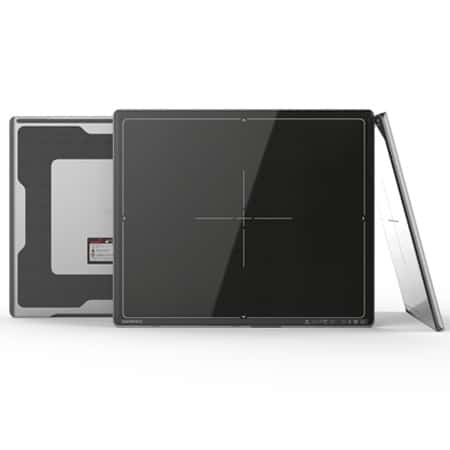
As mentioned in our previous blog post are three main variants of DR systems and their respective technology.
There are also different sizes available. In the following section we’ll go over the sizes and the different technologies and how each works and its pros and cons.
Currently, there are three common sizes of the radiographic areas for DR panels:
The actual size and weight of the DR panels can vary widely. Some have handles or protective covers built into the panel that can require retro-fits to the standard wall stand or table bucky.
For some Dr systems/panels the handle, protective covers and grids are optional or removable. To take into consideration when you want to browse for DR systems.
CCD technology comes in two variants, the single, large CCD and the multi-CCD array panels.
Single-CCD: This technology uses a GOS or CsI scintillator that converts the x-ray energy into visible light that is then bent using a prism where a picture of the image is then taken by a single, large charge coupled device (CCD), similar to what’s in a digital camera.
CCD Array: CCD array technology is similar to the single CCD except it has 200 individual CCDs arranged on the iside of the panel that capture 200 individual images that are then digitally stitched together before being displayed on the operator’s workstation.
Another DR sytem; Indirect Flat Panel Detectors work in much the same way as CCD panels in that x-ray energy is converted to visible light that is then captured and processed into a viewable image. However, these panels have a scintillator made of either Cesium Iodide (CsI) or Gadolinium Oxysulfide.
These scintillators release the visible light that is converted to a digital signal and read by an area of Thin Film Transistors (TFTs) instead of charge coupled devices.
To fully understand these types of panels it is important to make point out the differences between the scintillators:
Cesium Iodide (CsI)
Gadolinium Oxysulfide
This type of panel differs from either CCD or Indirect FPDs because the x-ray energy is not converted visible light and then read by TFTs or CCDs. Instead, the x-ray energy is absorbed directed by a sensitive material and then read by a TFT. These types of panels are often referred to as Selenium panels. This will be a giant factor for your Dr system.
Several manufactures now make DR panels that are wireless, making it an ideal DR system. The quality of the images can be just as high as tethered panels and are far more flexible in terms of use. They are often standard cassette size and fit easily within existing cassette trays. These panels are battery powered.